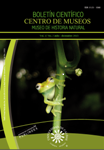Autores/as
Resumen
Objetivo: Comparar y analizar la correlación entre las concentraciones tiroideas séricas de 6 grupos de equinos (hembras jóvenes vs. machos jóvenes; hembras adultas vs. machos adultos; hembras jóvenes vs. hembras adultas; machos jóvenes vs. machos adultos; hembras vs. machos y jóvenes vs. adultos). Materiales y métodos: Se obtuvieron 99 muestras sanguíneas de caballos en estado de ayuno, diferenciados por género y edad (50 caballos menores de dos años: 25 hembras y 25 machos, y 49 caballos mayores de dos años: 25 hembras y 24 machos). Se determinaron los niveles de TSH y T4L mediante inmunoensayo enzimático. Resultados: Para el grupo de la fracción T4L según edad: jóvenes vs. adultos se encontró una diferencia significativa con un p-valor inferior a 0,05 igual a 0,005, con rangos promedio de 0,74 mg/dl jóvenes y 0,59 mg/dl adultos, con un nivel de confianza de 95%. De igual forma en el grupo de hembras jóvenes vs. hembras adultas en la fracción de T4L con rangos de 0,74 mg/dl y 0,56 mg/dl respectivamente, se halló una diferencia estadísticamente significativa con un p-valor inferior a 0,05 igual a 0,01. Para los demás grupos las diferencias en los valores de T4L y TSH, no fueron significativas (P ≥ 0,05). Conclusiones: Los resultados sugieren que las hembras jóvenes presentan niveles séricos más altos de T4L.
Palabras clave
Citas
BARAGLI, P. et al., 2011. Early evidence of the anticipatory response of plasma catecholamine in equine exercise. Equine Vet J., 31: 85-88.
BOOSINGER, T.R.; BRENDEMUEHL, J.P.; BRANSBY, D.L. et al. 1995. Prolonged gestation, decreased triiodothyronine concentration, and thyroid gland histomorphologic features in newborn foals of mares grazing Acremonion coenophialum-infected fescue. Am J Vet Res, 56, 66-9
BREUHAUS, B.A., 2011. Disorders of the Equine Thyroid Gland. Vet Clin North Am Equine Pract., 27 (1): 115-128.
BREUHAUS, B.A. & LAFEVERS, D.H. 2005. Thyroid function in normal, sick and premature Foals [abstract]. J Vet Intern Med, 19, 445.
BUFF, P.R. et al., 2007. Seasonal and pulsatile dynamics of thyrotropin and leptin in mares maintained under a constant energy balance. Domestic Animal Endocrinol., 33: 430-436.
CHRISTENSEN, R.A. et al., 1997. Acute effects of short-term feed deprivation and refeeding on circulating concentrations of metabolites, insulin-like growth factor i, insulin-like growth factor binding proteins, somatotropin, and thyroid hormones in adult geldings. J Anim Sci., 75: 1351-1358.
CROCKFORD, S.J., 2003. Thyroid rhythm phenotypes and hominid evolution: a new paradigm implicates pulsatile hormone secretion in speciation and adaptation changes. Comp Biochem Physiol AMol Integr Physiol., 135: 105-129.
DIVERS, J.T., 2008. Endocrine Testing in Horses: Metabolic Syndrome and Cushing's Disease. Equine Vet J., 28 (5): 315-316.
DONALD E.G. GRIESDALE, RUSSELL J. DE SOUZA, ROB M. VAN DAM. et al., 2008. Intensive insulin therapy and mortality among critically ill patients: a meta-analysis including NICE-SUGAR study data. CMAJ. 180(8): 821–827.
DOUGLAS, R. 1999. Circadian cortisol rhythmicity and equine cushing's-like disease. Equine Vet J, 19(11), 684, 750-751, 753.
DUCKETT WM. 1989. Thyroid gland. Equine internal medicine. 917–923.
FAZIO, E. et al., 2007. Total and free iodothyronine levels of growing Thoroughbred foals: Effects of weaning and gender. Livestock Science, 110 (3): 207-213.
FRANK, N. et al., 2002. Equine thyroid dysfunction. Vet Clin Equine, 18: 305-319.
FURR, M.O.; MURRAY, M.J. & FERGUSON, D.C. 1992. The effects of stress on gastric ulceration, T3, T4, reverse T3 and cortisol in neonatal foals. Equine Vet J, 24, 37-40.
HALLERMEIER KM , WU SM, STRATAKIS CA, CHAN CHY, BOURDONY CJ, RENNERT OM, et al., 1998. Genetic heterogeneity of adrenocorticotropin (ACTH) resistance syndromes: identification of a novel mutation of the ACTH receptor genein hereditary glucocorticoid deficiency. Mol Genet Metab., 64:256-65.
HULBERT, A.J., 2000. Thyroid hormones and their effects: a new perspective. Biol. Rev., 75: 519-631.
HURCOMBE, S.D., 2011. Hypothalamic-Pituitary gland axis function and disfunction in horses. Vet Clin Equine, 27: 1-17.
KRATZSCH, J. & PULZER, F., 2008. Thyroid gland development and defects. Best Pract Res Clin Endocrinol Metab., 22 (1): 57-75.
MEDICA, P. et al., 2011. 24-hour endocrine profiles of quarter horses under resting conditions. Equine Vet J., 31: 35-40.
MESSER, N.T. et al., 1998. Thyroid Hormone Levels in Thoroughbred Mares and Their Foals at Parturition. Proceedings of the Annual Convention of the AAEP, 44: 248-251.
TORIBIO, R.E., 2011. Endocrine dysregulation in critically ill foals and horses. Vet Clin North Am Equine Pract., 27 (1): 35-47.
TORIBIO, R.E. & DUCKETT, W.M., 2004. Equine Internal Medicine. Estados Unidos de América: Saunders.

 PDF
PDF
 FLIP
FLIP



















